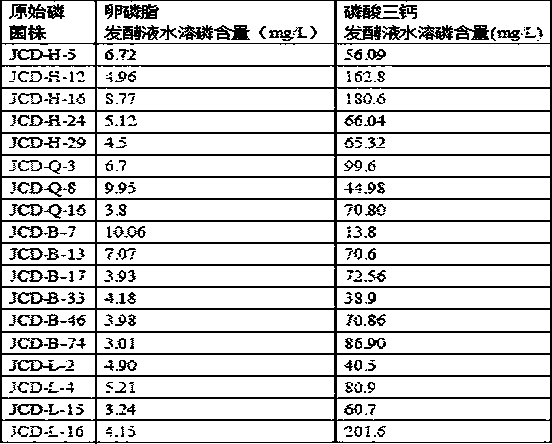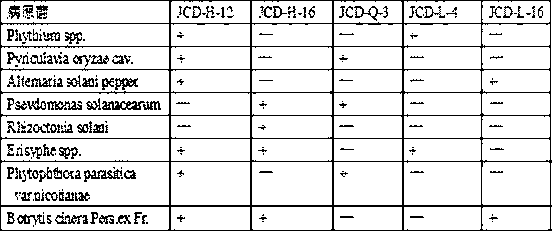Bacillus subtilis capable of decomposing phosphorus and high producing polyglutamic acid and application thereof
A Bacillus subtilis, polyglutamic acid technology, applied in the application, bacteria, fungicides and other directions, can solve the problems of undisclosed phosphorus solution, no phosphorus solution, etc., and achieve a broad antibacterial spectrum and broad-spectrum antibacterial effect. Effect
- Summary
- Abstract
- Description
- Claims
- Application Information
AI Technical Summary
Problems solved by technology
Method used
Image
Examples
Embodiment 1
[0017] Example 1: Isolation of Bacillus with Phosphorus Solubilizing Effect
[0018] 167 strains of Bacillus were isolated from Hunan, Changping, Hebei, Liaoning and other places, 101 of which had phosphorus-solubilizing activity.
[0019] 18 strains with high phosphorus-solubilizing intensity were screened. By measuring the aqueous solution phosphorus in the shake flask fermentation liquid of 18 bacillus strains, the decomposition ability of each bacterial strain to inorganic phosphorus and organic phosphorus was determined, as shown in Table 1. It can be seen from the results that the decomposition of inorganic phosphorus and the decomposition of organic phosphorus are not positively correlated. Based on the comprehensive understanding of organic phosphorus and inorganic phosphorus, we determined that five of them, JCD-H-12, JCD-H-16, JCD-Q-3, JCD-L-4, and JCD-L-16, had strong phosphorus-dissolving ability. The strain of action. Use the following two kinds of organic phosp...
Embodiment 2
[0026] Implementation 2 Screening of the antibacterial test of Bacillus with strong phosphorus-solubilizing effect
[0027] Put JCD-H-12, JCD-H-16, JCD-Q-3, JCD-L-4, JCD-L-16 in Pythium spp.,
[0028] Rice blast (Pyriculavia oryzae cav.), Pepper early blight (Alternaria solanipepper), Tomato bacterial wilt (Psevdomonas solanacearum), Rhizoctonia solani (Rhizoctonia solani), Powdery mildew (Erisyphe spp.),
[0029] Tobacco black shank (Phytophthora parasitica var.nicotianae), strawberry gray mold (Botrytiscinera Pers.ex Fr.) and other pathogenic microorganisms were marked with "crosses" on the plate, and after 72 hours of constant temperature cultivation at 28°C, observe whether there is a zone of inhibition. The results are shown in Table 2 below.
[0030] Table 2 Antibacterial test results of Bacillus with strong phosphorus-solubilizing effect
[0031]
Embodiment 3
[0032] Example 3 Identification of Bacillus subtilis JCD-H-16 and Test of Broad Spectrum Antibiotic Properties
[0033] Through physiological and biochemical tests, Gram-positive bacteria are rod-shaped, endophytic spores, and without flagella; they form milky white colonies on beef peptone medium, with smooth surfaces and irregular edges. Glucose fermentation test positive, starch hydrolysis test positive, gelatin liquefaction test positive, V.P reaction positive, contact enzyme reaction positive, methyl red reaction positive, nitrate reduction test positive, citrate utilization positive, aerobic growth, optimum pH The temperature is 6-8.5, the optimum temperature for growth is 28-38°C, and it is identified as Bacillus subtilis by 16s rDNA.
[0034] Take a ring of activated bacteria liquid from JCD-H-16 and cross-hatch it on a PDA plate, inoculate pathogenic bacteria at a distance of 3cm from the inoculation line, incubate at 28°C for 7 days, and measure the width of the inhi...
PUM
 Login to View More
Login to View More Abstract
Description
Claims
Application Information
 Login to View More
Login to View More - R&D
- Intellectual Property
- Life Sciences
- Materials
- Tech Scout
- Unparalleled Data Quality
- Higher Quality Content
- 60% Fewer Hallucinations
Browse by: Latest US Patents, China's latest patents, Technical Efficacy Thesaurus, Application Domain, Technology Topic, Popular Technical Reports.
© 2025 PatSnap. All rights reserved.Legal|Privacy policy|Modern Slavery Act Transparency Statement|Sitemap|About US| Contact US: help@patsnap.com



